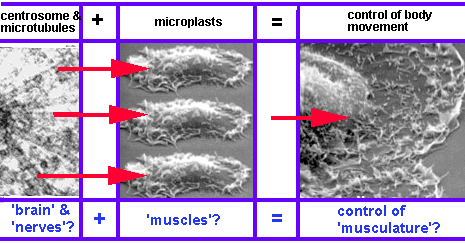

Left: Guenter Albrecht-Buehler. Picture courtesy of Northwestern University.
Right: How Guenter Albrecht-Buehler (Northwestern University Medical School, Chicago) believes animal cells "see" each other.


Albrecht-Buehler (2003a) believes that animal cells possess a kind of intelligence, and criticises the view that these cells are "rigidly operating chemical machines that derive their operating instructions internally from their genes and externally from chemicals and electrical signals emitted rigidly by other cells." He has made some intriguing claims regarding the centrosome, a spherical area near the nucleus of a cell, which (in animal cells but not in most plant cells) contains a pair of cylindrical structures called centrioles. Albrecht-Buehler claims that the centrosome is actually the control centre (or "brain") of an animal cell, while the centrioles function as the cell's "eyes". These "eyes" can detecting objects and other cells by pulsating near-infrared signals, and steer the cell towards their source. (The movement of animal cells differs from the phototactic behaviour of bacterial cells in several significant ways: bacteria, although light-sensitive, cannot see objects.) This means that cells can order and integrate a large amount of visual data.

Albrecht-Buehler believes that animal cells can navigate (see diagram), and that this ability is a manifestation of cell intelligence:
A moving cell has to operate its own body in sophisticated ways and, in addition, may have to navigate in space and time while dealing with numerous unforeseeable events, such as encounters with other cells and other objects that its genome could not possibly have anticipated. I think that cell motility, indeed, revealed cell intelligence.
Albrecht-Buehler's line of thinking here is that "the best place to start searching [for cell intelligence is] the field of cell movement."
This raises the question: is navigation a necessary condition for the possession of mental states? If we define navigation broadly to include any kind of sensory guidance, the answer is in the affirmative, as both sensory capacities (Conclusion S.3) and directed bodily movement (Conclusion A.3) are prerequisites for the ascription of mental states to organisms:
A.7 An organism must be capable of navigation (i.e. using its senses to steer itself around its environment) before its movements can be regarded as a manifestation of a cognitive mental state.
If Albrecht-Buehler is correct, animal cells are capable of a special kind of navigation - visual navigation - which enables them to see objects from a long distance, whereas bacteria are only capable of tactile navigation.
Additionally, animal cells possess internal movement programs, and are programmed to turn at certain times in their lives at certain angles. In order to do this, they have to be able to measure times and angles. According to Albrecht-Buehler, cells' internal movement programs are not fixed: cells can over-ride them when circumstances warrant it. For instance, when travelling along a "road" made of tiny ridges, they sometimes leave the road, to investigate something "interesting". To do this, they use the distant "clue" to derive a new heading, and follow it. They are even programmed to seek information about their surroundings if they encounter more than one path they can follow. At intersections, the cells extend projections called pseudopodia in all directions, removing obstacles and often changing directions.
Individual cells can even co-ordinate their movements with one another:
PtK1 cells can migrate in groups that are much faster than the single cells... Some cells even appear to turn their bodies into a single leading edge of the group while the bodies of other cells turn themselves into a tail of the group... Therefore, the motility control systems appear to be able communicate with each other about about shape changes, direction and timing (Albrecht-Buehler, 2003b).
If Albrecht-Buehler is correct, then these cells have sensors, but as we have seen (Conclusion S.3), this does not warrant the ascription to them of mental states. Neither does the fact that the cells have extensive computational abilities (shown by their ability to integrate visual data) require a mentalistic interpretation (Conclusion C.3).
Are the cells exhibiting flexible behaviour? To show this, we would have to show that they can acquire a new pattern of responding to a sensory stimulus (Conclusion F.3). Albrecht-Buehler's claim that the cells' internal movement programs are not fixed might seem to suggest that they are flexible. Another more likely interpretation, hinted at by Albrecht-Buehler, is that there are different levels of control within each cell. We could think of each cell as having a master program that governs its movements. The specific functions activated by the program may vary as environmental conditions change. However, the functions themselves, which describe the cells' patterns of responding to sensory stimuli, need not vary over time, nor would the program instructions need to change, so the cells' behaviour would remain inflexible by the definition I am using.
There is no evidence to date that the cells have a memory, owing to the difficulty of designing an experiment that would prove it. Nor is there any evidence that the cells have a "cognitive map" of their surroundings (Albrecht-Buehler, personal email, 30 September 2003). Since the existence of memory capacity in an organism is a necessary condition for ascribing cognitive mental states to it (Conclusion M.2), we have no warrant at present for saying that these cells have mental states.
A.8 The occurrence of navigation and guiding sensors in an organism does not provide a sufficient warrant for the ascription of mental states to it.